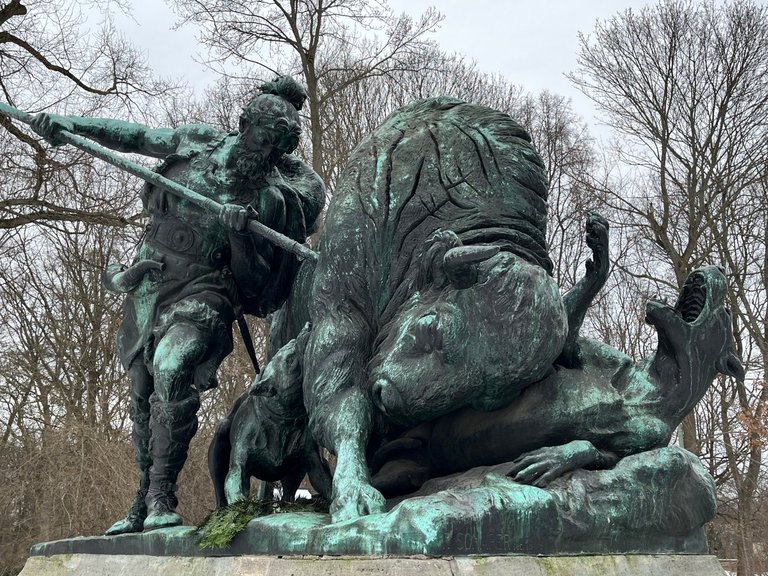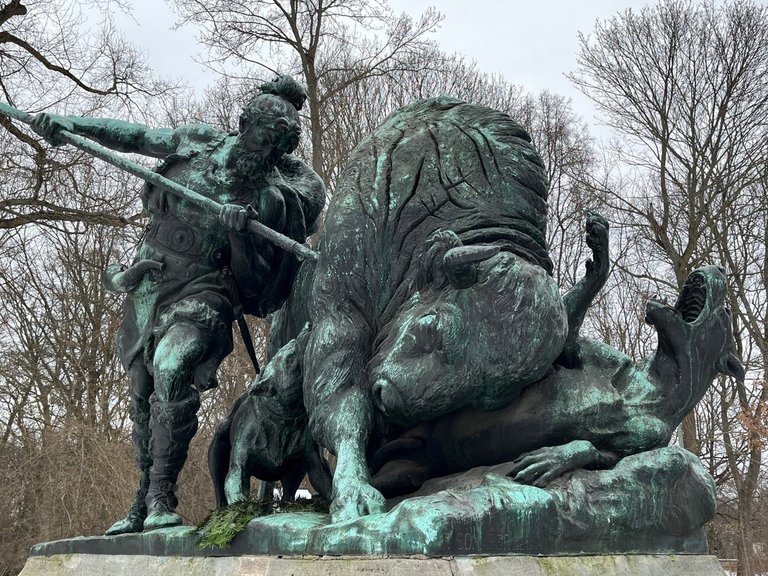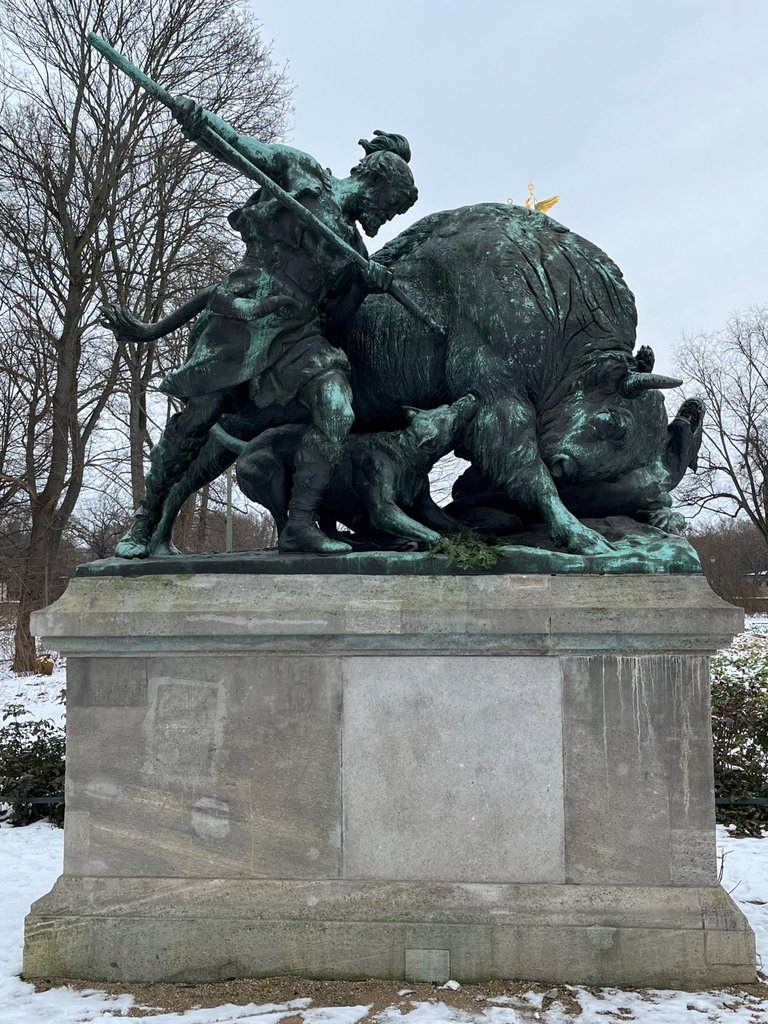Hello, dear readers! It's Morticia here, bringing you another fascinating piece from Berlin. Today, I want to share with you an intriguing sculpture I stumbled upon during a leisurely walk through Berlin's Tiergarten, specifically along the Fasanerieallee. The sculpture is titled "Altgermanische Wisentjagd," and it offers a captivating glimpse into both historical art and societal values.
Description and Artistic Context
The "Altgermanische Wisentjagd," which translates to "Old Germanic Bison Hunt," is a striking piece created by the renowned sculptor Fritz Schaper. Known for his neoclassical style and attention to detail, Schaper completed this piece in the late 19th century. The sculpture vividly depicts a scene from ancient Germanic mythology, where hunters are engaged in the perilous act of hunting a bison. The figures are rendered with dramatic realism, showcasing the intense struggle and raw power of both the hunters and the hunted animal. Standing before the sculpture, one cannot help but be drawn into the dynamic motion captured in bronze. The muscles of the hunters are taut with effort, and the bison’s powerful form is frozen in a moment of resistance. Schaper's ability to convey such vivid action and emotion is a testament to his skill and his deep understanding of both human and animal anatomy.

Historical and Stylistic Context
Fritz Schaper was a prominent figure in the German art scene during the late 19th and early 20th centuries. His works often reflect the neoclassical tradition, characterized by a focus on classical themes, realistic detail, and a balanced composition. "Altgermanische Wisentjagd" is no exception. It embodies the fascination of the time with mythological and historical themes, aiming to evoke a sense of the ancient past and its heroic narratives. The sculpture aligns with the broader historical context of German Romanticism and Nationalism, where there was a keen interest in the roots and legends of the Germanic peoples. It also reflects the era's artistic trends, which often glorified nature and humanity's interaction with it, albeit sometimes through a lens that idealized the violence of hunting and conquest.
Impact and Critique
Experiencing this sculpture in the serene setting of Tiergarten, I was struck by the contrast between the tranquil environment and the violent scene depicted. This juxtaposition prompts reflection on our historical relationship with animals and nature. The depiction of the bison hunt is undeniably dramatic and artistically impressive, but it also brings to light the often brutal reality of human dominance over wildlife. In today's context, such a scene can be unsettling, as it highlights a form of violence that many now view as unnecessary and cruel. It serves as a reminder of how far we've come in our understanding of animal rights and the importance of conservation. While the sculpture captures a moment from mythology and history, it also invites us to consider our current and future relationships with the animal kingdom.

Looking Forward
As I stood there, contemplating the "Altgermanische Wisentjagd," I felt a mixture of admiration for Schaper's artistic prowess and a hope for a future where the scenes we commemorate are those of harmony rather than conflict. It is my hope that as we move forward, our relationship with animals will continue to evolve towards one of mutual respect and care. This sculpture, while rooted in a historical narrative, can serve as a powerful symbol for change. It reminds us of our past, challenges us to think critically about our present, and inspires us to envision a future where humans and animals coexist peacefully.
Thank you for joining me on this reflective journey. I encourage you all to visit the Tiergarten and experience this piece for yourselves. Until next time, let's keep exploring and reflecting on the art and history that shape our world.
Ciao Kakao, Morticia
Ein Spaziergang durch die Geschichte: Die Skulptur "Altgermanische Wisentjagd" im Tiergarten, Berlin
Hallo, liebe Leser! Hier ist Morticia und bringt euch ein weiteres faszinierendes Stück aus Berlin. Heute möchte ich euch eine faszinierende Skulptur vorstellen, über die ich bei einem Spaziergang durch den Berliner Tiergarten, genauer gesagt entlang der Fasanerieallee, gestolpert bin. Die Skulptur trägt den Titel "Altgermanische Wisentjagd" und bietet einen fesselnden Einblick sowohl in die Kunstgeschichte als auch in gesellschaftliche Werte.
Beschreibung und künstlerischer Kontext
Die "Altgermanische Wisentjagd" ist ein eindrucksvolles Werk des bekannten Bildhauers Fritz Schaper. Schaper, der für seinen neoklassizistischen Stil und seine Liebe zum Detail bekannt ist, vollendete dieses Werk im späten 19. Die Skulptur stellt eine Szene aus der alten germanischen Mythologie dar, in der Jäger auf der gefährlichen Jagd nach einem Bison sind. Die Figuren sind mit dramatischem Realismus dargestellt und zeigen den intensiven Kampf und die rohe Kraft sowohl der Jäger als auch des gejagten Tieres. Wenn man vor der Skulptur steht, kann man nicht anders, als in die dynamische Bewegung hineingezogen zu werden, die in Bronze festgehalten wurde. Die Muskeln der Jäger sind vor Anstrengung angespannt, und die kraftvolle Form des Bisons ist in einem Moment des Widerstands eingefroren. Schapers Fähigkeit, Handlung und Emotionen so lebendig darzustellen, zeugt von seinem Können und seinem tiefen Verständnis der menschlichen und tierischen Anatomie.

Historischer und stilistischer Kontext
Fritz Schaper war eine prominente Figur in der deutschen Kunstszene des späten 19. und frühen 20. Jahrhunderts. Seine Werke stehen häufig in der Tradition des Neoklassizismus, der sich durch die Konzentration auf klassische Themen, realistische Details und eine ausgewogene Komposition auszeichnet. Die "Altgermanische Wisentjagd" ist keine Ausnahme. Sie verkörpert die Faszination der damaligen Zeit für mythologische und historische Themen und soll ein Gefühl für die antike Vergangenheit und ihre heroischen Erzählungen hervorrufen. Die Skulptur fügt sich in den breiteren historischen Kontext der deutschen Romantik und des Nationalismus ein, in dem es ein starkes Interesse an den Wurzeln und Legenden der germanischen Völker gab. Sie spiegelt auch die künstlerischen Tendenzen der Epoche wider, die oft die Natur und den Umgang des Menschen mit ihr verherrlichten, wenn auch manchmal durch eine Brille, die die Gewalt der Jagd und der Eroberung idealisierte.
Wirkung und Kritik
Als ich diese Skulptur in der ruhigen Umgebung des Tiergartens sah, war ich beeindruckt von dem Kontrast zwischen der ruhigen Umgebung und der dargestellten gewalttätigen Szene. Diese Gegenüberstellung regt zum Nachdenken über unsere historische Beziehung zu Tieren und zur Natur an. Die Darstellung der Bisonjagd ist unbestreitbar dramatisch und künstlerisch beeindruckend, aber sie bringt auch die oft brutale Realität der menschlichen Herrschaft über die Tierwelt ans Licht. Im heutigen Kontext kann eine solche Szene beunruhigend sein, da sie eine Form der Gewalt verdeutlicht, die viele heute als unnötig und grausam ansehen. Sie erinnert daran, wie weit wir in unserem Verständnis von Tierrechten und der Bedeutung des Naturschutzes gekommen sind. Während die Skulptur einen Moment aus der Mythologie und der Geschichte festhält, lädt sie uns auch dazu ein, über unsere gegenwärtigen und zukünftigen Beziehungen zum Tierreich nachzudenken.

Blick nach vorn
Als ich dort stand und die "Altgermanische Wisentjagd" betrachtete, empfand ich eine Mischung aus Bewunderung für Schapers künstlerisches Können und Hoffnung auf eine Zukunft, in der die Szenen, derer wir gedenken, von Harmonie und nicht von Konflikt geprägt sind. Ich hoffe, dass sich unsere Beziehung zu den Tieren auf dem Weg in die Zukunft weiter in Richtung gegenseitiger Achtung und Fürsorge entwickeln wird. Diese Skulptur ist zwar in einer historischen Erzählung verwurzelt, kann aber als kraftvolles Symbol für den Wandel dienen. Sie erinnert uns an unsere Vergangenheit, fordert uns auf, kritisch über unsere Gegenwart nachzudenken, und inspiriert uns, uns eine Zukunft vorzustellen, in der Menschen und Tiere friedlich koexistieren.
Vielen Dank, dass Sie mich auf dieser nachdenklichen Reise begleiten. Ich möchte Sie alle ermutigen, den Tiergarten zu besuchen und dieses Werk selbst zu erleben. Bis zum nächsten Mal, lasst uns weiter die Kunst und die Geschichte, die unsere Welt prägen, erforschen und darüber nachdenken.
Ciao Kakao, Morticia
 |  |  |
| Don't forget to reshare! | For every reshare/rehive you will get one of my Proof-of-Reshare NFTs. Current Edition: Morticia #4 only 30 pices | Don't forget to reshare! |
Congratulations, your post has been added to Pinmapple! 🎉🥳🍍
Did you know you have your own profile map?
And every post has their own map too!
Want to have your post on the map too?
Congratulations @city-of-berlin! You received the biggest smile and some love from TravelFeed! Keep up the amazing blog. 😍 Your post was also chosen as top pick of the day and is now featured on the TravelFeed front page.
Thanks for using TravelFeed!
@for91days (TravelFeed team)
PS: You can now read your favourite travel blogs on your phone. Plus, blogging on-the-go just got easier! Download our app on the Apple App Store or get it on Google Play.